
The king sport in our country is increasingly developing and accompanied by many stadiums built to serve this sport. In Vietnam today, there are many large stadiums equipped with modern equipment to best serve the matches. It can be said that the stadium in our country can now be as bright as other countries in Southeast Asia. Let’s find out with the Vinlove some of the biggest stadiums in Vietnam.
Can Tho Stadium
Can Tho Stadium is a football stadium in Ninh Kieu District, Can Tho City. This is the largest capacity stadium in Vietnam (more than My Dinh Stadium) with 60,000 seats. The stadium not only hosts football but also holds a motorcycle racing tournament. The yard is located on the banks of the Hau River, next to the old Can Tho ferry wharf, on Le Loi street, Cai Khe ward, Ninh Kieu District, Can Tho city. The satellite stadium is Military Zone 9 stadium.
Capacity (estimated):
- Stand A: 20,000 seats (85 VIP seats).
- Stand B: 20,000 seats.
- Stand C: 10,000 seats.
- Stand D: 10,000 seats.
- Seats above stands B, C, D: 5,000 seats.
- Total is: 60,000 seats, 5,000 standing seats (in case of running out of seats).
The stadium was built during the French colonial period, after being repaired and upgraded in 1981, Can Tho stadium was said to be the largest capacity stadium in Southeast Asia at that time. Recently, after being repaired to serve the National Phu Dong Health Association in 2012, the capacity of the stadium was reduced to 5,000 seats, but it is still the largest capacity stadium in Vietnam today.
The field is divided into 4 stands with 4 different colors (green, red, yellow, blue). Stand A is considered a newly built VIP stand of about 80 billion with a roof and the entire stand is fitted with seats. Stands B, C, D follow each other in a C shape with concrete arranged similar to stairs, in 2019 three stands B, C, D have been fitted with all blue plastic seats instead of steps. by concrete. A unique feature of Can Tho Stadium are the stands built in the style of embankment forming the basin of the stands. At the top of the stands is a road about 6m wide so that everyone can walk easily. Because the stands are covered with soil, people have planted rows of green trees right outside to create natural shade. The size of the pitch is according to international standards 120m x 90m, quality grass, still ensuring good performance in heavy rain conditions. In addition, the yard also has 2 technical rooms for television stations, press agencies, 8 running tracks, 4 motorcycle racing tracks, modern electronic scoreboards and 4 lamp posts for matches and games. events in the evening.
Address: Cai Khe, Ninh Kieu, Can Tho
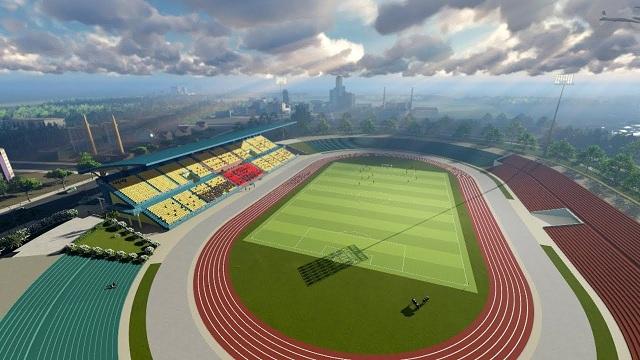
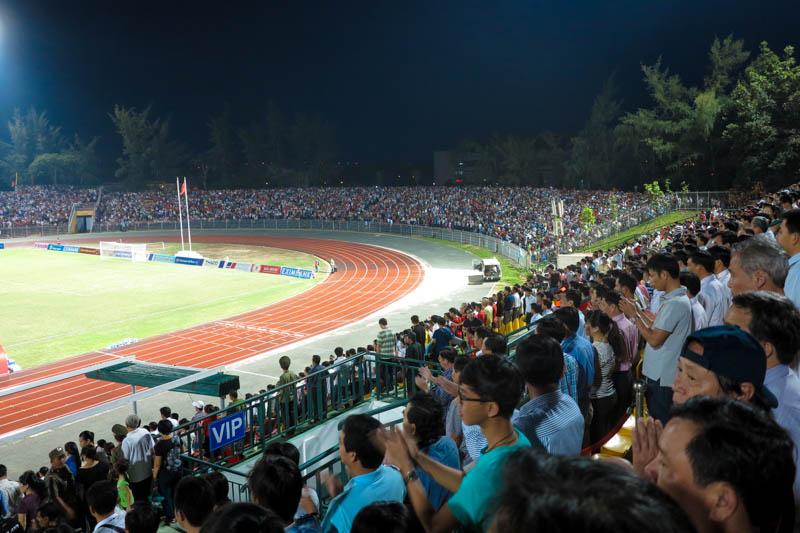
My Dinh National Stadium – Hanoi
Stadium My Dinh National (English: My Dinh National Stadium) is the national stadium in Hanoi, Vietnam with a capacity of 40 192 seats, Vietnam’s second-largest (after the stadium Tho).
- Located at Le Duc Tho Street (My Dinh 1 Ward, Nam Tu Liem District), 10 km southwest of Hanoi center, My Dinh Stadium is the second largest stadium in Vietnam (after the stadium). Can Tho campaign, can accommodate 60,000 people). The construction cost of My Dinh stadium is US$52,983 million with the winning unit being HISG Group (China).
- With a designed capacity of 40,192 seats (450 VIP seats, 160 seats for press reporters) , My Dinh Stadium is the center of Vietnam’s National Sports Complex. The main category is a football field measuring 105 meters by 68 meters. Combined with it is the athletics category with 8 laps of 400 meters and 10 straight tracks of 110 m; 2 high jump holes; 2 pits for throwing weights, throwing javelins, throwing weights with chains; 2 double pole vaults, 2 double long jump zones. Total area (1 main yard, 2 training grounds): 17.5 ha.
- The yard has 4 stands: the western stand (stand A) and the east stand (stand B) have 2 floors, 25.8 meters high; The northern stands (stand C) and the south (stand D) have 1 floor, 8.4 meters high. Around the stadium, there are 419 function rooms. The lighting system of the yard consists of 355 bulbs arranged in 4 columns, 54 meters high. The roof of the stadium weighs 2,300 tons, aperture 156 meters, diameter 1.1 meters. Le Duc Tho Street, My Dinh 1 Ward, Nam Tu Liem District, Hanoi, Vietnam
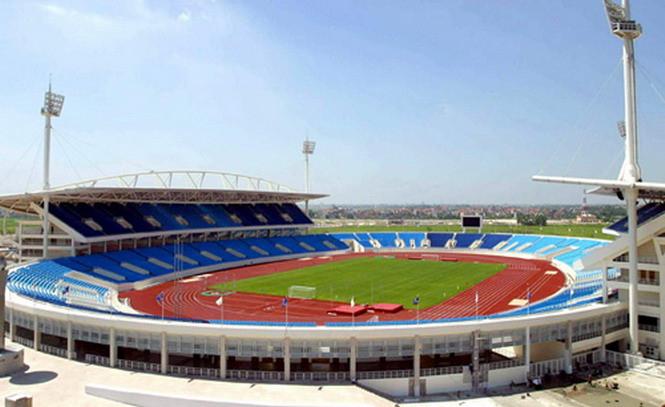
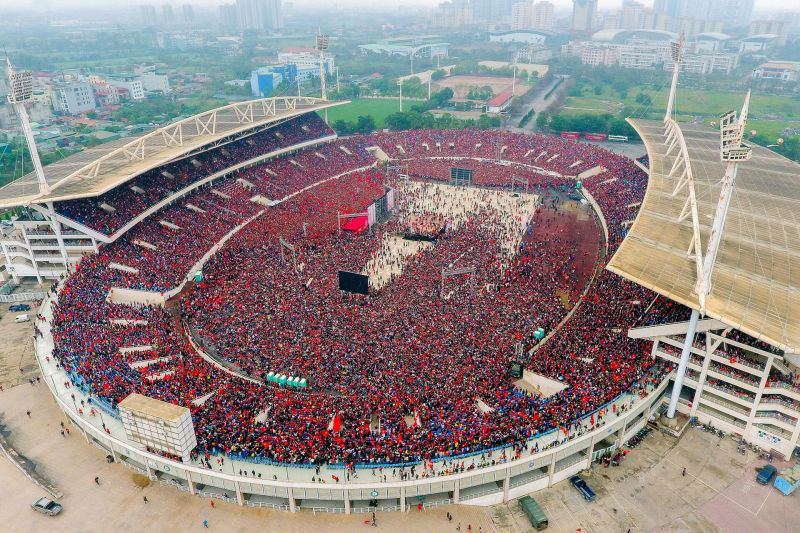
Lach Tray Stadium – Hai Phong
Lach Tray Stadium is a stadium located on Lach Tray Street, Ngo Quyen District, Hai Phong City, Vietnam. This is one of the largest stadiums in Vietnam with a capacity of about 30,000 seats. Currently, Lach Tray is the home ground of Hai Phong football club (formerly Hai Phong Police football club), one of the most traditional football clubs in Vietnam.
During the 22nd SEA Games in 2003, the stadium was honored to host women’s football. In addition to football and athletics, many other sports competitions, as well as major cultural events, are held in this stadium.
- Stand A: is the most modern stand with a capacity of 15000 people, including two floors with a roof that covers the entire stand, in the direction of East-North, going to the direction of Lach Tray Street.
- Stand B: two-storey ceramic with a roof, facing southwest in the direction of Chu Van An street, with seats installed according to the letter Lach Tray, with a capacity of about 10,000 people, the gathering place of the most enthusiastic fans.
- Stands C and D: stands farthest from the goal, without seats, roof, capacity 2500 in each stand.
Address: 15 Lach Tray, Le Loi, Ngo Quyen, Hai Phong
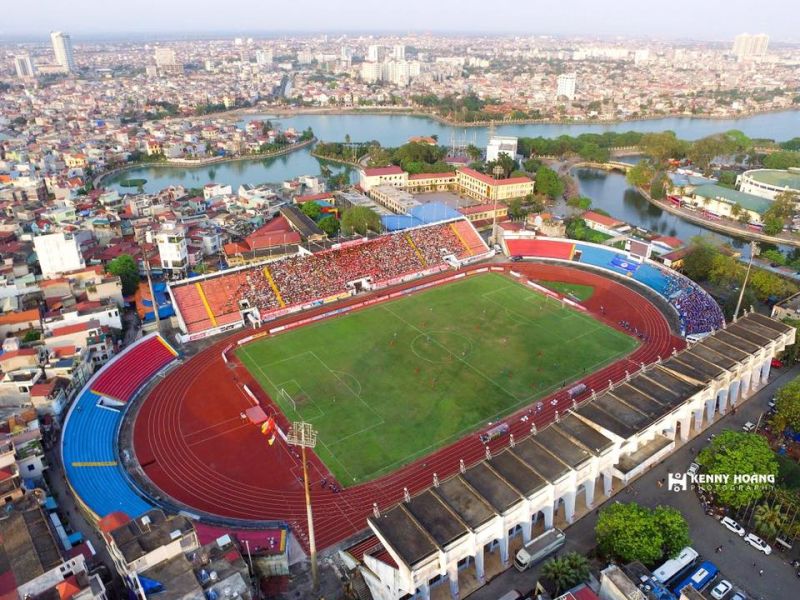
Thong Nhat Stadium- Ho Chi Minh City
Thong Nhat Stadium is one of the “busiest” stadiums of the Vietnamese football village. This place is often chosen as the venue for many major domestic tournaments. Thong Nhat Stadium, built-in 1968, is a famous stadium of Vietnam.
- It is known that before the liberation of Saigon, it was called Cong Hoa Stadium. This project is designed by a Japanese engineer. In particular, this is the central stadium to organize sports competitions of the Saigon government.
- This Thong Nhat Stadium is located at 138 Dao Duy Tu Street, District 10, Ho Chi Minh City. This football field has undergone two field upgrades. It has been rehabilitated with grass and rehabilitated synthetic resin running track. Moreover, the stadium also has new international standard lights for the 22nd Sea Games. It is still the main venue for many domestic and international sporting events.
- Thong Nhat Stadium (Thong Nhat stadium) has a fairly large capacity of up to 25,000 spectators (later upgraded to 40,000). It is known that the forerunner of Thong Nhat Stadium is Renault Stadium. Before 2003, Thong Nhat Stadium was considered the largest and most modern football field in Vietnam. Here the football village chooses to be the National Stadium. In 2005, Thong Nhat Stadium was again prepared for the 2006 National Sports Festival. However, in this repair, the quality of the renovation was considered to be quite bad. In addition, the construction period in this phase took too long. By the end of June 2007, Thong Nhat Stadium had been spent 14 billion VND for the second renovation.
- In many fake football seasons, Thong Nhat Stadium has always been the home choice of 1 or 2 teams for the national championship. Particularly for the three seasons of 2013, 2014, 2015, no national football team chose Thong Nhat. However, in the 2016 V-League, the Saigon FC team chose Thong Nhat Stadium as the home ground.
Map of Thong Nhat Stadium
Used to be the largest and most modern football field of Vietnamese football. Not only that, this place was also chosen as the National Stadium. There are many factors for this Thong Nhat stadium to make a “reputation” for a while. In particular, it is impossible not to mention its design that contributes to this popularity. A closer look at the map of Thong Nhat stadium will help you understand how famous it once was. The stadium stands can accommodate nearly 19,450 seats, including:
- Stands A1 – A2 – A3: 2,250 seats (with roof). In which, the VVIP stands are arranged with 18 seats, VIP 192 seats.
- The stands for sections A4 to A5 have 4,000 seats (2,000 for each stand).
- Stand B has 5,000 seats.
- Stands C and D have 8000 seats (4,000 for each stand).
- In 2018, during the break of seasons, Thong Nhat Stadium upgraded the facilities here. Accordingly, the stadium has changed the lighting and reassembled the seats in stands B and A4, A5.
Address : No. 138 Dao Duy Tu Street, District 10, Ho Chi Minh City.
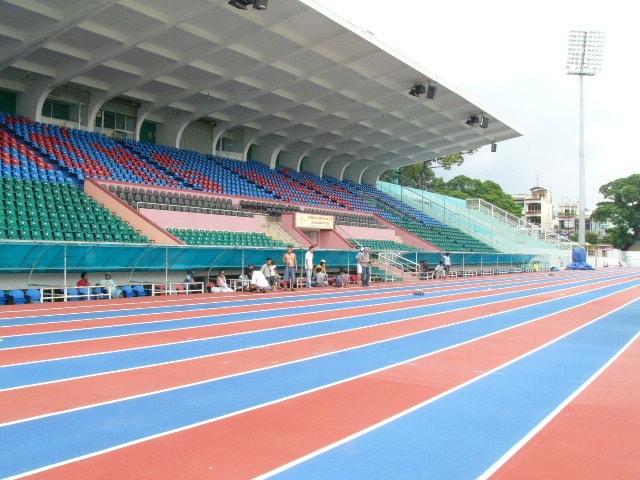
Dong Nai Stadium
Dong Nai Stadium is a stadium located in Bien Hoa, Dong Nai, owned by Dong Nai province, Dong Nai FC The stadium is designed with a natural grass surface to hold football tournaments.
- Just before the new 2015 season, Dong Nai Stadium has put on a more beautiful and fresh appearance, refreshing the track of the athletics field with 8 new red synthetic resin-covered warm-up lanes. At the same time, concreted and planted grass in front of stand A in the stadium, and painted the stands.
- Hopefully in the future, when the A-stand area continues to be rebuilt, Dong Nai stadium will have a new look and meet the standards of a more professional football team.
Address : Dong Khoi Street, Tan Hiep Ward, Bien Hoa, Dong Na
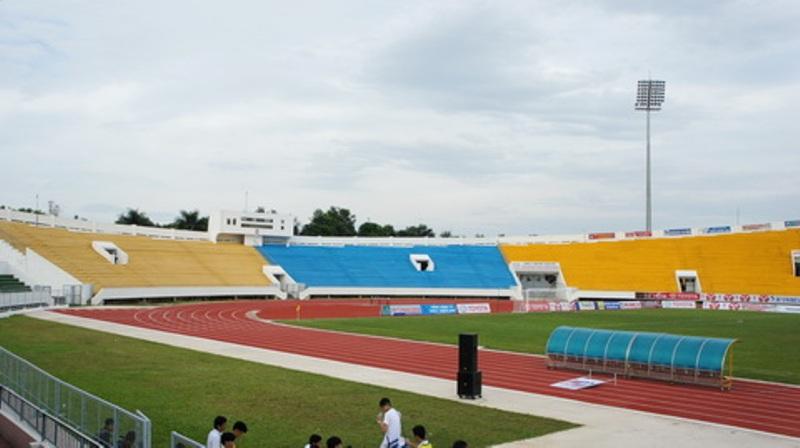
Freedom Stadium
Tu Do Stadium is a stadium located in the center of Hue city, Thua Thien-Hue province, Vietnam with a capacity of about 25,000 seats. The Court of Freedom was built by the French in the early 1930s and named Stade Olympique de Hué. Later, the Nguyen Dynasty changed the name of the stadium to Bao Long Stadium (Bao Long was the crown prince of King Bao Dai and Queen Nam Phuong) when this stadium was inaugurated to coincide with the birthday of the last crown prince. same in Vietnamese history. This is the home ground of Hue football club (formerly Thua Thien-Hue football club).Address: Nguyen Cong Tru Street- Hue City, Vietnam
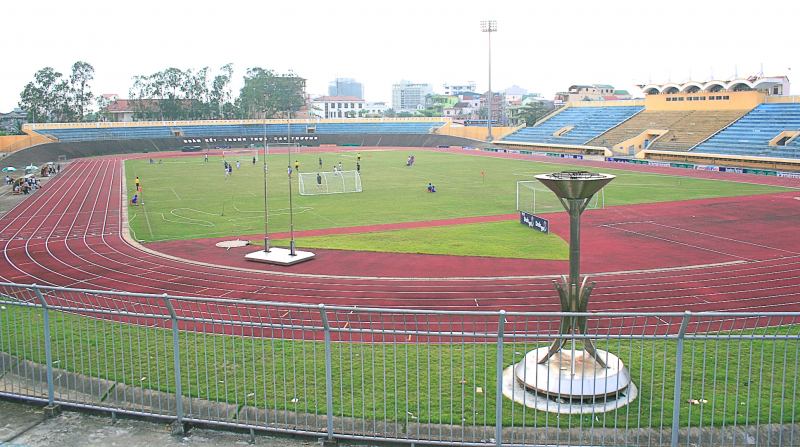
Hang Day Stadium
Hang Day Stadium is a stadium located on Trinh Hoai Duc Street, Hanoi, Vietnam with a capacity of about 22,580 seats. Before the My Dinh National Stadium, Hang Day was the venue for the matches of the Vietnam national football team as well as the women’s and Olympic teams. This is also the place to organize many sports and cultural events of Hanoi and Vietnam. In 1998, the opening matches, Group B and Tiger Cup final were held here. During the period from 2000 to 2006, Hang Day stadium was renamed to Hanoi stadium. Hang Day Stadium is currently the home ground of Hanoi, Viettel and Phu Dong.
- During its 60-year history , Hang Day yard has been repaired and upgraded many times to meet international standards. Most notably in the 90s to serve the 1998 Tiger Cup with a new and modern lighting system; modify the pitch, change the grass; install seats, electronic clocks, electronic boards; expand and raise the capacity to more than 30,000 seats.
- In 2017, this project was also upgraded again with a cost of more than 10 billion VND after Hanoi city decided to hand over the stadium to Hanoi football team T&T. In the early 2000s, in order to prepare for the 22nd SEA Games in 2003 in Vietnam, this stadium and the surrounding space were upgraded and re-planned. However, after 2010 the yard began to deteriorate and reached a serious and dangerous level in 2015. In 2017, this work was also upgraded again with a cost of more than 10 billion VND after Hanoi city. decided to hand over the field to Hanoi T&T football team.
- At the beginning of 2018, this group announced a plan to demolish and rebuild the entire Hang Day stadium with a cost of up to 250 million euros (about 7 trillion VND). Bouygues Group (France) received this contract and started construction from the fourth quarter of 2018. According to the design, the new Hang Day stadium has 4 basements, 2 floors and a grandstand to form a cultural, sports and service complex, instead of just serving sports as it is now. The new Hang Day Stadium is expected to have no piste, a capacity of 20,000 spectators, and a roof according to FIFA standards. In particular, the football field is located on the second floating floor, above a series of service and cultural facilities such as cinemas, event centers or basement parking systems, serving the entire population. adjacent residential area.
Address: No. 9, Trinh Hoai Duc Street, Cat Linh Ward, Dong Da District
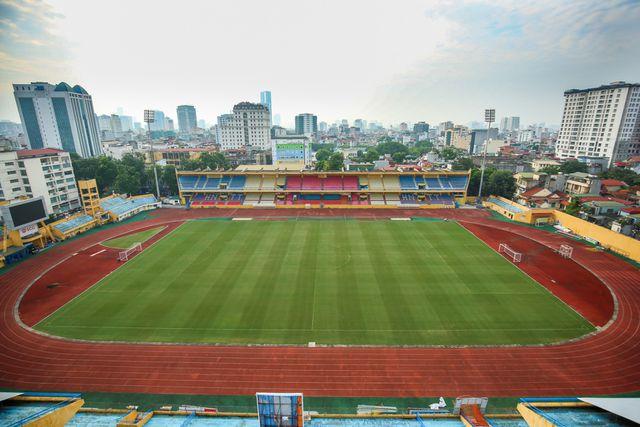
Hoa Xuan Stadium
Hoa Xuan Stadium is a football stadium in Cam Le District of Da Nang City, Vietnam, with a capacity of up to 20,000 seats. As the home ground of SHB Da Nang, it has no piste and is the second stadium in Vietnam after Pleiku in Gia Lai that is only used to organize football matches.
- Hoa Xuan Stadium was built with a total cost of about 300 billion VND, located in Hoa Xuan Ward, Cam Le District, Da Nang City.
- The stadium has a capacity of 20,000 seats, built on a land lot of 66,530m2. The stadium has 4 stands. Stand A is 5 floors high, stands B, C, D are 1 floor high. Below the stands, there are refreshment areas, function rooms, and toilets.
- The ground surface will be planted with Princess 77 grass, American granular bermuda, herringbone underground drainage system, and an automatic watering system for the yard. The pitch has 140 super VIP seats (with tables) at the center of stand A; install the anti-riot fence system as well as the fence separating the stands B, C, D; system of signs, instructions and nameplates of functional rooms; electronic board with time, information and match scores; sound on the field with backup power.
Address: Hoa Xuan, Cam Le, Da Nang, Vietnam
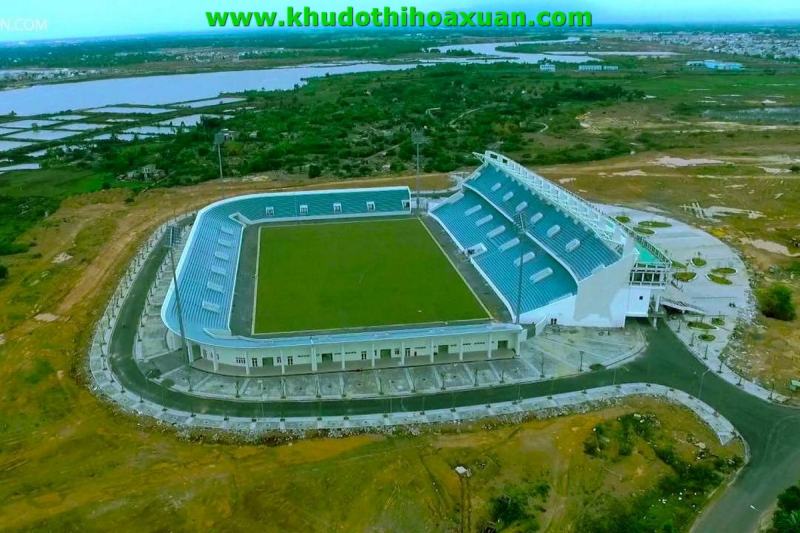
Above are the major stadiums in Vietnam with a capacity of tens of thousands of people and many modern dining and entertainment complexes that have contributed to the resounding success of national or international tournaments in recent years.
Photo: Internet
